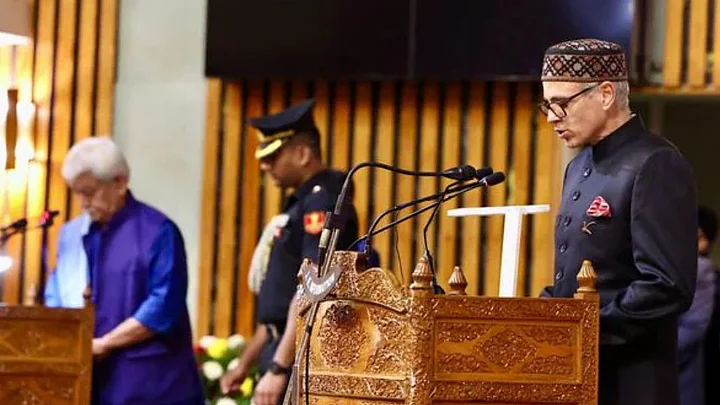Omar Abdullah played several political aces while taking over as the first chief minister of the union territory of Jammu and Kashmir on 16 October, Wednesday.
The big one was inducting Surinder Chowdhary as his deputy chief minister. The title is largely ornamental but carries much symbolic importance. For, it gives the people of the Jammu Division, particularly Hindus there, a sense that they have importance in the government.
By inducting three of his five ministerial colleagues from the Jammu Division, Omar ensured that the Jammu region had half the berths. No one can complain of discrimination – at least on the basis of ministerial representation.
As far as overall influence over the government is concerned, the region’s Hindus are in any case more than adequately looked after since most of the powers within the government of the union territory vest with the lieutenant governor, who is an appointee of, and accountable to, the Bharatiya Janata Party's (BJP) government at the Centre.
Cocking a Snook – Subtly
By taking these steps, Omar pulled the rug from under the argument that Jammu’s people, especially Hindus, would have scant representation in the new government. That argument has been pushed by BJP backers in the media ever since the Assembly election results were declared early last week.
The move not only deflates that argument, but it also subtly cocks a snook at the BJP, since Chowdhary defeated the BJP state president, the voluble Ravinder Raina, from the Nowshehra constituency, where many of the Hindus who were ethnically cleansed from Pakistan-controlled parts of the erstwhile state resettled in 1947-48.
Chowdhary is said to be a Jat (of which there are a few, both Hindu and Muslim, in the erstwhile state), but he could broadly be counted among the nebulous identity group known as 'Pahadi'.
That is another little dig at the BJP, for the party had hoped to gain much electoral momentum from Pahadi votes after it defied norms to give the grouping scheduled tribe status. However, only one BJP candidate was elected from J&K’s 'Pahadi' belts – Poonch, Rajouri, Karnah, and Gurez.
Chowdhary’s appointment, albeit largely symbolic, could help to pull Pahadi support to the National Conference (NC). It is thus a political masterstroke, both to assuage fears of neglect among Jammu residents and to subtly weaken the BJP politically.
Thanks to Poonch and Rajouri
Wisely, Omar inducted a well-respected Gujjar leader, Javed Rana, who has been elected from Mendhar in the Poonch district. Rana’s brother, former vice-chancellor Masood Chowdhary, is a revered icon for many Gujjars in the Jammu Division.
Between Chowdhary and Rana, Omar has effectively covered the Poonch and Rajouri districts, which are often together called the Pir Panchal region of the union territory, as well as the two major communities that live there – Gujjars and Pahadis.
The eight members those two districts elect to the Assembly can make a vital difference to a majority. Plus, it is now part of the sprawling and geographically unwieldy Anantnag-Rajouri Lok Sabha constituency.
Indeed, Omar’s inductions from there may also be seen as a gesture of appreciation to the region for electing his colleague, Mian Altaf, to the Lok Sabha four months ago, and for sending six members of the NC-Congress alliance to the new Assembly.
On the other hand, these appointments are also an investment for a repeat of those results next time round.
Choice for Jammu
Omar’s decision to induct Satish Sharma, the independent who won from Chhamb, is also sensible. Along with the deputy chief minister, Sharma’s induction makes two Hindus (or one-third) in the ministry. At 42, Sharma is young but has watched politics closely since his father was the Congress MP from Jammu from 2004 to 2014, and an MLA before that.
Conversely, the people of Jammu are used to taking their problems to the Sharmas and depend on them to represent them well. Satish’s uncle is a leading BJP politician, having crossed to the ruling party from the Congress some years ago.
The Samba-Kathua-Ramnagar-Udhampur quadrilateral at the corner of the state nearest the highway to Pathankot, and the rest of India beyond, will also have to make do with being represented by Sharma.
The absence of a minister from there might be read as a message to both the people of the area, who backed the BJP, and the Congress, which failed to pull its weight in the NC-Congress alliance.
Given a ceiling on the number of ministers permitted, Omar has invested wisely.
Chenab Blues
Omar has not included a minister from the upper Chenab basin, where the districts of Kishtwar, Doda, and Ramban lie. However, if the party sends Khalid Suhrawardy to the Rajya Sabha, that region will feel adequately represented.
Suhrawardy is the hereditary Imam of the Jamia mosque in Doda town, and the family has been closely allied with the NC since a previous Imam became close to Sheikh Abdullah when the latter spent time in Bhaderwah jail many decades ago.
Suhrawardy came third in the recent elections, polling fewer votes than both the BJP and the winner, who is of the Aam Aadmi Party. The latter has offered support to the NC government, allowing it to reach the majority mark in the new assembly.
The region around the upper Chenab has almost as many Hindus as Muslims, and so is a potential communal tinderbox. It is likely that Omar will find a way to make the region feel included since inclusion seems to be his watchword.
(The writer is the author of ‘The Story of Kashmir’ and ‘The Generation of Rage in Kashmir’. He can be reached at @david_devadas. This is an opinion piece and the views expressed above are the author’s own. The Quint neither endorses nor is responsible for the same.)
(At The Quint, we question everything. Play an active role in shaping our journalism by becoming a member today.)
